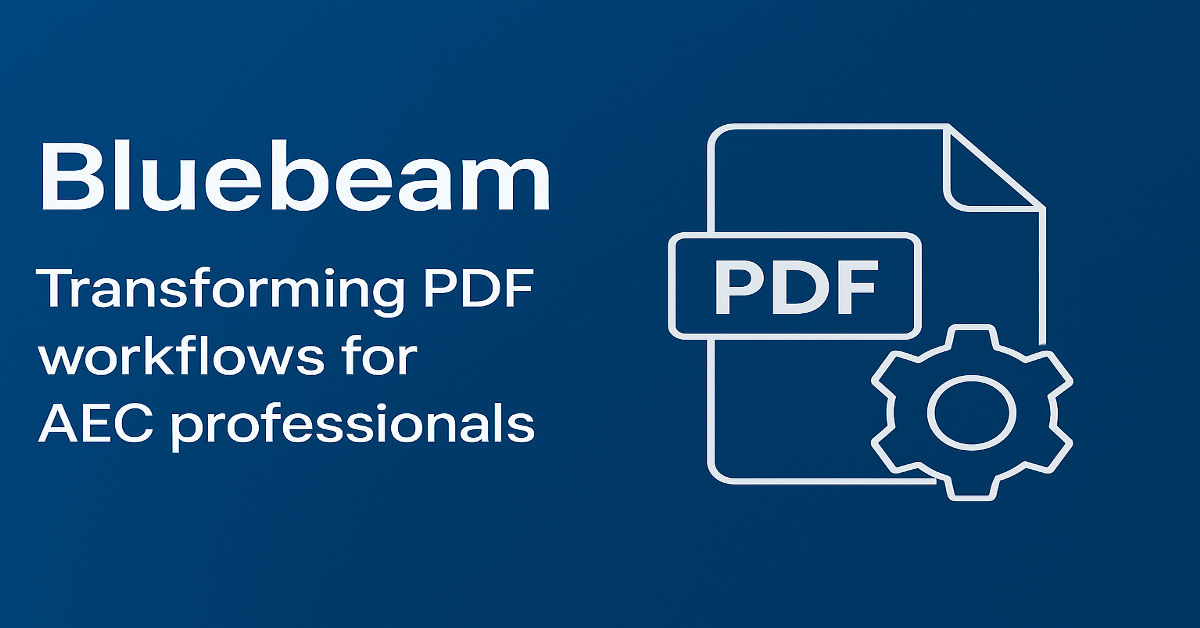In the architecture, engineering and construction (AEC) industries, digital tools have become vital for efficiency and collaboration. One such standout tool is Bluebeam. Known for revolutionizing how professionals handle PDF documents, Bluebeam is widely adopted for its intuitive interface and robust capabilities.
This article explores the core functionality, real-world applications, and industry benefits of Bluebeam. Whether you’re new to it or seeking to deepen your understanding, this guide will provide valuable insights.
Table of Contents
- What is Bluebeam?
- Core Features of Bluebeam Revu
- Why Bluebeam is Essential for AEC Professionals
- Real-World Applications of Bluebeam
- Benefits of Using Bluebeam in Project Management
- Bluebeam vs Traditional PDF Tools
- Bluebeam Revu Editions: Which One Is Right for You?
- Integrations and Compatibility
- Training and Support Resources
- Frequently Asked Questions (FAQs)
- Conclusion
What is Bluebeam?
Bluebeam is a specialized software solution primarily designed to help AEC professionals manage, edit, and collaborate on PDF documents. Its flagship product, Bluebeam Revu, turns static PDFs into dynamic workspaces. This software enables users to annotate, measure, and manage workflows all within a single platform.
Originally launched in 2002, Bluebeam has since become a global standard in construction and engineering firms due to its precision and project tracking capabilities.
Core Features of Bluebeam Revu
Bluebeam Revu is packed with features that elevate it above standard PDF tools. Below are some standout features:
- Markup Tools: Add comments, annotations, shapes, text, and highlights to PDFs.
- Measurement Tools: Accurately measure lengths, areas, volumes, and counts.
- Studio Sessions: Collaborate in real-time with team members, regardless of location.
- Document Management: Split, merge, and reorder PDF files efficiently.
- Batch Tools: Apply markups or perform actions to multiple files at once.
- Tool Chest: Save and reuse custom markups and tools.
- Hyperlinks and Bookmarks: Navigate large documents quickly and easily.
Table: Key Features Comparison
| Feature | Description | Benefit |
| Markup Tools | Annotate with text, lines, highlights, and shapes | Improves communication |
| Measurement Tools | Length, area, volume calculations | Accurate estimations |
| Studio Sessions | Real-time collaboration on documents | Boosts teamwork |
| Batch Processing | Handle multiple files simultaneously | Saves time |
| Tool Chest | Store and reuse custom tools | Consistency in documentation |
| Hyperlinks/Bookmarks | Easy navigation within large documents | Enhances user experience |
Why Bluebeam is Essential for AEC Professionals
AEC professionals handle a vast amount of technical documentation. Bluebeam simplifies this by offering precision, collaboration, and accountability in digital workflows. Here’s why it stands out:
- Time Efficiency: Reduce time spent on manual markups.
- Project Clarity: Enhanced communication through shared annotations.
- Error Reduction: Precision tools help minimize calculation mistakes.
- Remote Collaboration: Studio features ensure global team access.
- Cost Savings: Optimized workflows translate into lower overheads.
Real-World Applications of Bluebeam
Bluebeam is used in a variety of real-world construction and design scenarios:
- Design Review: Architects and engineers mark up drafts collaboratively.
- Construction Documentation: Contractors document changes and updates.
- Site Logistics: Use layered PDFs to plan and visualize site layouts.
- Punch Lists: Assign tasks and track completion in real-time.
- RFIs and Submittals: Manage and respond to requests within the document.
Benefits of Using Bluebeam in Project Management
Effective project management in construction depends on accurate documentation and team coordination. Bluebeam streamlines this process with features tailored for project managers:
- Version Control: Maintain a history of document changes.
- Status Tracking: Visual indicators show task progress.
- Standardization: Reusable templates ensure document uniformity.
- Integration with Project Management Tools: Sync with platforms like Procore and SharePoint.
Bluebeam vs Traditional PDF Tools
Traditional PDF readers offer limited capabilities, primarily viewing and basic annotations. Bluebeam Revu, however, provides:
- Advanced markup capabilities
- Measurement tools built for construction
- Real-time collaboration with Studio
- Batch processing for large document sets
- Customizable tool sets for branding and consistency
This makes Bluebea’m a preferred choice for professionals needing more than just simple PDF viewing.
Bluebeam Revu Editions: Which One Is Right for You?
Bluebea’m Revu comes in three editions:
- Revu Standard
- Best for: General contractors, architects, engineers
- Includes: PDF editing, markup, and collaboration tools
- Revu CAD
- Best for: Design professionals needing CAD integration
- Includes: All Standard features + plugins for AutoCAD, Revit, etc.
- Revu eXtreme
- Best for: Power users and large teams
- Includes: OCR, batch tools, scripting, and advanced automation
Table: Bluebeam Revu Editions Comparison
| Edition | Features | Best For |
| Standard | PDF markup, measurement, Studio | Contractors, Engineers |
| CAD | CAD plugins, 2D/3D PDF creation | Architects, Design Professionals |
| eXtreme | Batch processing, scripting, OCR | Enterprise Teams, Power Users |
Integrations and Compatibility
Bluebeam works well within an ecosystem of digital tools. It supports:
- File Compatibility: PDF, DWG, DWF, and more
- Cloud Services: SharePoint, Dropbox, Google Drive
- Project Platforms: Procore, Autodesk, Bentley
- Device Compatibility: Windows and iOS (via Bluebea’m Cloud)
These integrations help teams centralize workflows and reduce app-switching.
Training and Support Resources
To help users maximize their software investment, Bluebea’m provides extensive learning resources:
- Bluebeam University: Online courses and certifications
- Webinars: Live and recorded training sessions
- Knowledge Base: Articles, FAQs, and how-to guides
- Customer Support: Live chat, email, and phone assistance
Training boosts team proficiency and speeds up adoption.
Conclusion
Bluebeam is more than a PDF editor—it’s a complete digital workflow solution tailored to the demanding needs of AEC professionals. By transforming how documents are created, reviewed, and managed, Bluebea’m has earned its place as an industry essential.
Whether you’re overseeing construction, managing design workflows, or streamlining document collaboration, Bluebea’m provides the tools to work smarter and more efficiently.
Ready to elevate your project workflows? Explore Bluebea’m today and experience the power of smarter document management.
Frequently Asked Questions (FAQs)
What industries use Bluebea’m the most?
Architecture, engineering, construction, and manufacturing are the primary industries using Bluebea’m.
Can Bluebea’m be used on a Mac?
While Bluebea’m Revu is Windows-based, Bluebea’m Cloud supports browser-based access for Mac users.
Is Bluebea’m suitable for small businesses?
Yes, especially with the Standard edition, which offers essential features at a lower cost.
Does Bluebea’m require internet access?
Basic functionality works offline. However, Studio Sessions and Bluebea’m Cloud require internet access.
What is the difference between Bluebea’m Revu and Bluebea’m Cloud?
Bluebea’m Revu is desktop software; Bluebea’m Cloud enables access to markups and files via a web browser.







